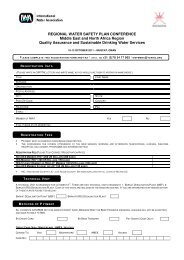Water safety in buildings - libdoc.who.int - World Health Organization
Water safety in buildings - libdoc.who.int - World Health Organization
Water safety in buildings - libdoc.who.int - World Health Organization
You also want an ePaper? Increase the reach of your titles
YUMPU automatically turns print PDFs into web optimized ePapers that Google loves.
can become colonized with bacteria, fungi and protozoa. Most of these organisms are<br />
of limited significance, but pathogenic species, <strong>in</strong>clud<strong>in</strong>g Legionella, Pseudomonas<br />
aerug<strong>in</strong>osa and Mycobacterium spp., have been detected (Sehulster et al., 2004).<br />
2.5.4 Aged-care facilities and retirement homes<br />
Aged-care facilities and retirement homes house elderly people <strong>who</strong> can be more<br />
susceptible to waterborne disease. In some cases, residents will have underly<strong>in</strong>g illnesses<br />
that <strong>in</strong>crease this susceptibility.<br />
Like hospitals, water systems can be extensive and supply water to wards and rooms<br />
that are not always occupied. Hot-water distribution systems may be ma<strong>in</strong>ta<strong>in</strong>ed at lower<br />
temperatures or have thermostatic mix<strong>in</strong>g valves <strong>in</strong>stalled to reduce the risk of scald<strong>in</strong>g.<br />
2.5.5 Child-care facilities<br />
Child-care facilities can cater for very young children <strong>who</strong> can be more susceptible to<br />
disease. Children’s hygiene is not always well developed, and attention needs to be paid<br />
to keep<strong>in</strong>g water outlets and toilets clean (Adams et al., 2009). Young children are also<br />
more susceptible to contam<strong>in</strong>ants such as lead (WHO, 2008). Corrosion and leach<strong>in</strong>g of<br />
metals such as lead can be exacerbated by <strong>in</strong>termittent water use, with stagnation over<br />
weekends and dur<strong>in</strong>g holidays.<br />
Hot-water distribution systems may be ma<strong>in</strong>ta<strong>in</strong>ed at lower temperatures or have<br />
thermostatic mix<strong>in</strong>g valves <strong>in</strong>stalled to reduce the risk of scald<strong>in</strong>g.<br />
2.5.6 Small hotels, bed-and-breakfasts, farmstays and campsites<br />
Hotels, motels and bed-and-breakfasts provide water for dr<strong>in</strong>k<strong>in</strong>g and bath<strong>in</strong>g for guests<br />
and may use dr<strong>in</strong>k<strong>in</strong>g-water supplies <strong>in</strong> water-us<strong>in</strong>g devices, such as swimm<strong>in</strong>g pools<br />
and hot-tub pools. In some cases, rooms can be provided with s<strong>in</strong>gle-use hot-tub baths.<br />
Some facilities may have private water supplies that can be potential sources of microbial<br />
and chemical hazards.<br />
Campsites can <strong>in</strong>clude permanent build<strong>in</strong>gs provid<strong>in</strong>g shared facilities (e.g. for cook<strong>in</strong>g,<br />
bath<strong>in</strong>g). In some cases, separate non-dr<strong>in</strong>k<strong>in</strong>g-water supplies may be provided for<br />
bath<strong>in</strong>g. These need to be appropriately marked us<strong>in</strong>g words as well as symbols, not<strong>in</strong>g<br />
that the water is not suitable for dr<strong>in</strong>k<strong>in</strong>g.<br />
Like hotels, these accommodation facilities can be subject to seasonal use.<br />
2.5.7 Sport<strong>in</strong>g facilities and health centres<br />
Sport<strong>in</strong>g facilities and health centres can <strong>in</strong>clude sports grounds, stadiums, leisure centres,<br />
swimm<strong>in</strong>g pools, ice r<strong>in</strong>ks, health clubs and fitness centres. These facilities can <strong>in</strong>clude<br />
swimm<strong>in</strong>g pools or hot-tub pools.<br />
Swimm<strong>in</strong>g pools have been associated with outbreaks of illnesses such as<br />
cryptosporidiosis, and hot-tub pools with legionellosis and hypersensitivity pneumonitis<br />
(from mycobacteria). Indoor pools can generate elevated levels of chloram<strong>in</strong>es and<br />
other dis<strong>in</strong>fection by-products, which can lead to eye, nasal and respiratory irritation.<br />
Dis<strong>in</strong>fection byproducts at <strong>in</strong>door pool centres could be associated with asthma <strong>in</strong><br />
children (Weisel et al., 2009).<br />
14 <strong>Water</strong> <strong>safety</strong> <strong>in</strong> build<strong>in</strong>gs


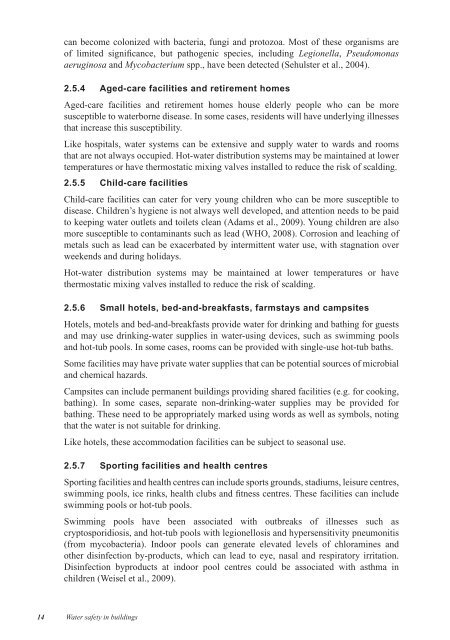
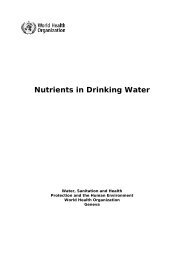
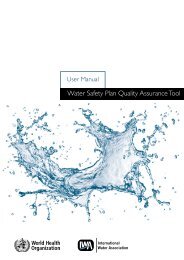

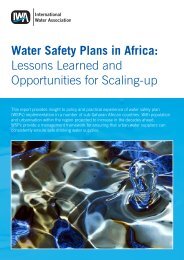

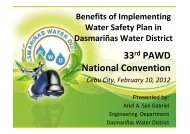
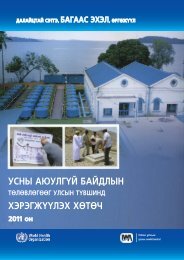

![Pdf [5.32 Mb] - Water Safety Portal](https://img.yumpu.com/32098467/1/190x245/pdf-532-mb-water-safety-portal.jpg?quality=85)
